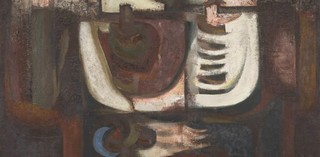Queensland Art Gallery Celebrates Maverick Artist Jon Molvig

Jon Molvig, Australia, 1923-1970 / Eden industrial: The garden (from 'Eden industrial' series) 1961 / Oil treated with blow torch on composition board / 185 x 246.6cm. Collection: Queensland Art Gallery | Gallery of Modern Art. / View full image
The Queensland Art Gallery celebrates the life and work of one of Australia’s founding expressionist painters with the opening of ‘Jon Molvig: Maverick’ this weekend.
QAGOMA Director Chris Saines said Jon Molvig was a passionate and rebellious painter – a relentless innovator, whose key works were created in Brisbane in the 1950s and 60s.
‘The exhibition ‘Maverick’ highlights the productive yet relatively short career of an intensely complicated artist and individual who died at the age of only 47,’ Mr Saines said.
‘Although born in Newcastle, it’s significant that Molvig chose to live here in Brisbane where, with great energy, he created innovative figure studies, portraits and landscapes, and made radical stylistic shifts in technique and approach to suit his subject matter. It was in Brisbane that he built a national reputation.’
Exhibition curator Michael Hawker said Jon Molvig projected the image of a fiercely independent, feverishly driven artist.
‘He cultivated the persona of an outsider, a maverick who distanced himself from the acknowledged art centres of Sydney and Melbourne,’ Mr Hawker said.
‘This is the first survey of Jon Molvig’s work in almost two decades and it features more than 100 paintings and works on paper drawn from national, state, regional and private collections.
‘Among the highlights in the exhibition are Molvig’s figure studies and acutely insightful portraits of artists and local identities, his boldly gestural paintings of women, lovers, brides and grooms, and reflections on the human condition. These works challenged the conservative art scene of Brisbane at the time, but garnered national attention.
‘In 1966 Molvig won the sought-after award Archibald Prize with a portrait of artist and friend Charles Blackman. This work appears in ‘Maverick’ alongside Molvig’s other Archibald entries such as Self‑portrait 1956, Portrait of Russell Cuppaidge 1959, James Finney 1960, and his 1963 painting of fellow artist Joy Roggenkamp.
‘Equally essential to the artist’s varied output were Molvig’s depictions of the Australian landscape - the ‘Centralian’ series inspired by a formative trip to Central Australia and Uluru in 1958 and 1959, ‘Eden industrial’, a number of densely layered, blowtorched paintings from the early 1960s, and ‘Tree of man’, ten works from 1968 that represent his final artistic statement.
‘Aside from his achievements as an artist, Molvig was an inspiring teacher who mentored a whole generation of younger Brisbane artists including Mervyn Moriarty, Andrew Sibley, John Aland and Ann Thomson.
‘He exerted a formidable presence and influence on artists and the arts scene in our city. Brisbane was a catalyst for his development as an artist and inspired his greatest work and it was from here that his influence spread,’ Mr Hawker said.
From 11.30am this Saturday 14 September audiences can join Michael Hawker for a tour of ‘Jon Molvig: Maverick’ and from 1.30pm hear a talk on Molvig by independent writer and curator Samantha Littley.
Additional talks on the exhibition will be presented from 11.30am on Sunday 27 October (with Michele Helmrich, former Associate Director, Curatorial, The University of Queensland Art Museum); Sunday 10 November (with Glenn R Cooke, former Research Curator, Queensland Heritage, QAGOMA); and Sunday 2 February (with Bruce Heiser, art dealer, valuer and researcher, and Michael Hawker).
‘Jon Molvig: Maverick’ continues until 2 February, 2020.
Jon Molvig (1923‑70)
Jon Molvig was born in Newcastle in 1923 and his mother died when he was two years old. After an unhappy, unsettled childhood he went on to serve in New Guinea and the Philippines during World War Two. Molvig studied art at East Sydney Technical College from 1947-49 before travelling in Europe until 1952. After settling in Brisbane in 1955, he worked voraciously up until his premature death from renal failure in 1970.
For more information visit www.qagoma.qld.gov.au.

